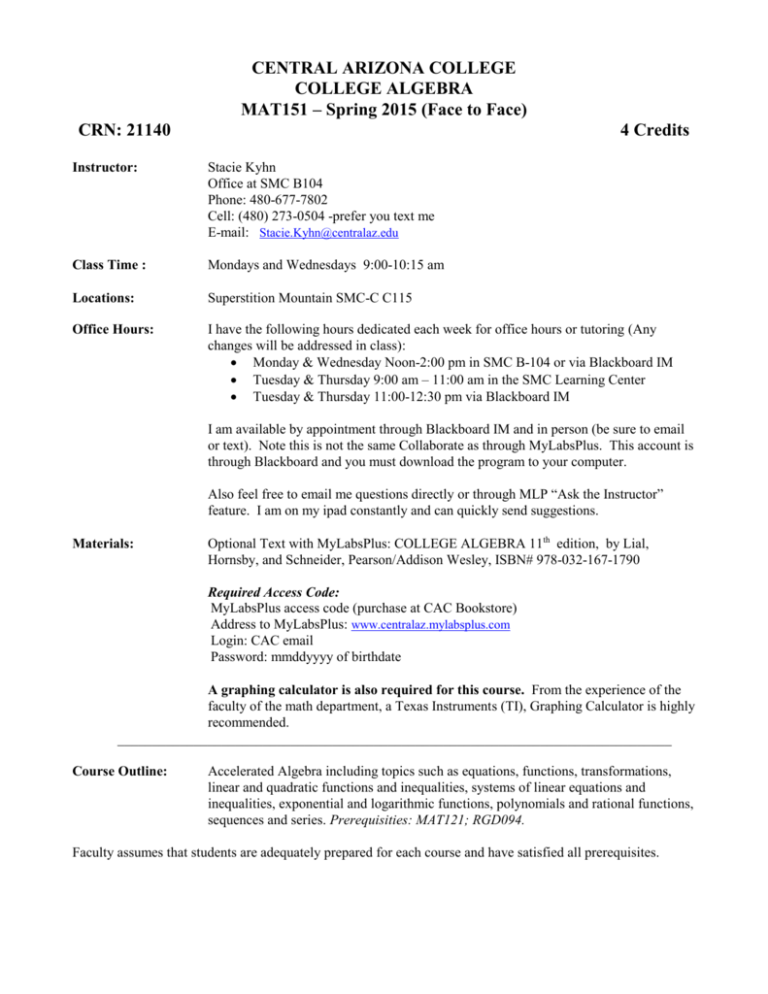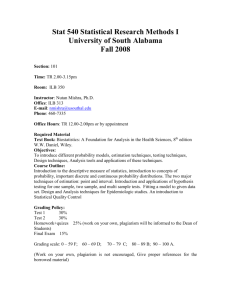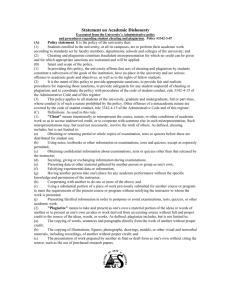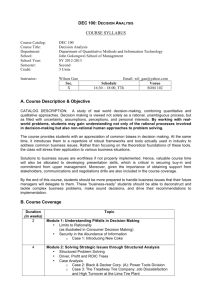
CENTRAL ARIZONA COLLEGE
COLLEGE ALGEBRA
MAT151 – Spring 2015 (Face to Face)
CRN: 21140
4 Credits
Instructor:
Stacie Kyhn
Office at SMC B104
Phone: 480-677-7802
Cell: (480) 273-0504 -prefer you text me
E-mail: Stacie.Kyhn@centralaz.edu
Class Time :
Mondays and Wednesdays 9:00-10:15 am
Locations:
Superstition Mountain SMC-C C115
Office Hours:
I have the following hours dedicated each week for office hours or tutoring (Any
changes will be addressed in class):
Monday & Wednesday Noon-2:00 pm in SMC B-104 or via Blackboard IM
Tuesday & Thursday 9:00 am – 11:00 am in the SMC Learning Center
Tuesday & Thursday 11:00-12:30 pm via Blackboard IM
I am available by appointment through Blackboard IM and in person (be sure to email
or text). Note this is not the same Collaborate as through MyLabsPlus. This account is
through Blackboard and you must download the program to your computer.
Also feel free to email me questions directly or through MLP “Ask the Instructor”
feature. I am on my ipad constantly and can quickly send suggestions.
Materials:
Optional Text with MyLabsPlus: COLLEGE ALGEBRA 11th edition, by Lial,
Hornsby, and Schneider, Pearson/Addison Wesley, ISBN# 978-032-167-1790
Required Access Code:
MyLabsPlus access code (purchase at CAC Bookstore)
Address to MyLabsPlus: www.centralaz.mylabsplus.com
Login: CAC email
Password: mmddyyyy of birthdate
A graphing calculator is also required for this course. From the experience of the
faculty of the math department, a Texas Instruments (TI), Graphing Calculator is highly
recommended.
________________________________________________________________________________
Course Outline:
Accelerated Algebra including topics such as equations, functions, transformations,
linear and quadratic functions and inequalities, systems of linear equations and
inequalities, exponential and logarithmic functions, polynomials and rational functions,
sequences and series. Prerequisities: MAT121; RGD094.
Faculty assumes that students are adequately prepared for each course and have satisfied all prerequisites.
Class Regulations:
1. Arrive on time to class with assignments. If you must leave early, inform me before class begins.
Attendance is recorded at the beginning of class. If you arrive late, it is your responsibility to inform me
so that I can record your attendance as tardy rather than absent.
2. Be prepared to answer questions in class, participate in groups and work problems on the board.
3. Show work, including steps to demonstrate that you know the material. Answers only are not sufficient
when steps are needed.
4. Communicate with the instructor by asking questions, using e-mail, or leaving a phone message.
5. Turn off cell phones before entering classroom.
6. Talking that interferes with student/teacher interaction is not acceptable and you will be asked to leave
the classroom. Remember: The instructor has the right to teach and your classmates have paid to learn.
7. Cheating will result in a zero grade for all individuals involved or may result in removal from the class
or campus as outlined in the “Student Code of Conduct” (Policy Number 589). Copying answers
without attempting the work is considered cheating!
8. CAC policies will be followed and any disciplinary actions will be pursued in the event of any
violations regarding the “Student Code of Conduct” and the “Declaration of Civility”.
Note to Students:
The Instructor reserves the right to change the delivery of course content based on
the needs of the class.
Attendance:
As stated in the Student Handbook, the student is expected to attend every class.
Promptness is required. When the number of absences exceeds 4 hours, the student
may be withdrawn. In order to drop the class, a withdrawal form needs to be
completed. Failure to complete the withdrawal form will result in a final grade of F.
Course Work:
For every credit hour earned for the course, the student will spend a minimum of 30
hours of student homework and 15 hours of lecture/recitation (See Arizona Board of
Regents Credit Hour Requirements). This means we will have 60 hours lecture and a
minimum of 120 hours of homework, tests and quizzes.
Calculators:
A graphing calculator is required for this course. From the experience of the
faculty of the math department, a Texas Instruments (TI), Graphing Calculator is
highly recommended. I will be using a TI–83 plus or TI-84 in the classroom. There
are calculators available through the STEM grant. See me for additional information.
Cell Phones:
Cell phones are not appropriate in the classroom. They should be turned off and out of
sight. If there is an emergency and you are waiting for a call, please have the phone on
vibrate. Cell phones may not be used as your calculator
Computer:
The computer component of this course is called MyLabsPlus (MLP). The web
address is http://www.centralaz.mylabsplus.com. Your login is your full CAC email
address. Your password is your eight digit date of birth such as August 16th, 1980
would be 08161980. Any time you want to change your login and password go to
MyProfile on the top right of the home screen.
Homework:
Your homework will be on the computer, in the book or handouts. Check the due dates
in MLP to make sure you complete all assignments in a timely manner. Late
assignments will NOT be accepted. Expect to spend a minimum of 8 hours per week
completing assignments for this class.
Videos:
Videos are required to be watched for each section. This will give you a good
overview of the section before starting your homework. Videos do not necessarily
cover the entire section, so reading the online text may also be necessary and helpful.
Quizzes:
Most quizzes will be taken on the computer and are not proctored. However, I may
give some in class quizzes and these may be individual and/or group quizzes. No
make-ups are given for in class quizzes.
College Algebra Assessment Tests:
All exams except the Final will be taken in the Testing Center. The final exam will be taken in the
classroom during the regular final exam schedule. See the weekly calendar for the date and time.
Students may use the following items on the proctored exams:
1. One 3"×5" note card with hand written formulas/examples on both sides. However, the card will be
collected and discarded at the completion of the test.
2. A graphing calculator (TI 89, 92, and TI NSpire CAS are not allowed)
3. Pencils/pens and eraser.
There will be no retakes and no curves on the midterm or final. Make-ups will be given only when
appropriate documentation is provided and accepted by your instructor. All make-ups must be completed
immediately upon return to school.
Quizzes will be taken in class or on the computer approximately every week and account for 10% of your grade.
Below are links to the Testing Center. Be sure to schedule your midterm Exam before the deadline date in the
course calendar toward the end of this document.
CAC Testing Center Hours can be found at:
http://www.centralaz.edu/Home/Student_Resources/Testing/Testing_Centers.htm
If testing at a Non-CAC Testing Site go to:
http://www.centralaz.edu/Home/Student_Resources/Testing/Proctored_Testing.htm to see more details about the
appropriate procedures for proctored testing.
Grading:
A.........90 - 100%
B..........80 - 89%
C..........70 - 79%
D..........60 - 69%
F........... 0 - 59%
Hw (MyLabsPlus)
Hw (Written and outside MyLabsPlus work)
Quizzes:
Proctored Exams:
10%
10%
10%
70%
Note: Math is not a spectator sport. It requires continuous practice and persistence. Get help as soon as you
need it. I maintain an open-door policy. The Learning Center (TLC) is also a reliable option when needing
extra help. See the CAC webpage to see more details at the various sites:
http://www.centralaz.edu/Home/Student_Resources/Academic_Support/Tutoring.htm
Reasonable Disability Accommodations: Central Arizona College seeks to provide reasonable
accommodations for all qualified individuals with disabilities. The College will comply with all applicable
federal, state and local laws, regulations, and guidelines with respect to providing reasonable accommodations
as required to provide an equal educational opportunity. It is the student's responsibility to register with the
Disability Resource Service Office and discuss their specific needs with the Disability Resource Service
Coordinator to determine reasonable accommodations. Once the student registers with the Disability Resource
Service Office and provides documentation identifying the need for accommodations, an Accommodation Plan
will be provided to the student. It is the student’s responsibility to show the Accommodation Plan to their
instructor. The Disability Resource Service Office is located in the M building at the Signal Peak Campus.
Students may contact the Disability Resource Service Coordinator at 520.494.5409 to set up a one on one
meeting. The Disability Resource Service Coordinator travels to all campuses and centers. All information is
kept confidential.
CAC recognizes the seriousness of plagiarism, which is defined as turning in someone else's work and calling it
your own. At CAC plagiarism is treated as a dishonest action, an issue of dishonorable behavior.
There are two types of plagiarism to beware of--intentional and unintentional plagiarism. Intentional plagiarism
is an obvious type of cheating that includes turning in writing that you are falsely presenting as your own. It
may be writing that was produced by a roommate, a spouse, an essay bought from the Internet, and passages
copied from a research source such as a book, magazine, or web site. Allowing another student to copy your
work is another type of intentional plagiarism.
In addition, students are expected to avoid unintentional plagiarism, which means including in your own work
and passing off as your own writing, phrases, sentences, paragraphs, or more, that are only slightly changed
from the original source. To avoid unintentional plagiarism, you must paraphrase properly and identify the
original writer and source; this is called citing your work. Citations can be done in a few different formats, and
your instructors are eager to help you learn how to cite your sources correctly. Unintentional plagiarism can
also include passing off somebody else’s ideas (not just words) as your own without indicating that the idea or
information came from somewhere else. Finally, unintentional plagiarism also can be allowing someone else to
make significant wording alterations or editing changes to your writing.
Penalties for plagiarism, according to CAC's Violations of the Student Code of Conduct, can be severe. They
may range from failure of an assignment to failure of a course, to referral to the Dean, to dismissal from a
program of study. These actions are not meant to be threatening, but to ensure that students understand that the
school takes plagiarism seriously. The underlying message of the CAC plagiarism policy is that instructors are
committed to encouraging student writers to use source material correctly and develop the confidence to
express themselves in their own unique ways.
Cheating in Class:
Don’t even think about it. Students caught cheating, attempting to cheat, or assisting in the cheating of
another student will be expelled from the class and given a course grade of “F”.
Withdrawals & Incompletes:
Effective Fall 2013, all faculty must report students who do not show up to class within the first week of
classes.
Start Date/Week
January 16/20
January 26
February 2
February 9
February 16
February 23
March 2
March 9
March 16
March 23
March 30
April 6
April 13
April 20
April 27
May 4
May 11
Non- Stand. Length
Class
Length of Class (Must withdrawal by Thursday of)
5 week (3 Week)
8 week (5th Week)
10 week (6th Week)
16 week (10th
Week)
February 5
February 19
February 26
April 2 **
February 12
February 26
March 5
April 2
February 19
March 5
March 12
April 9
February 26
March 12
March 19
April 16
March 5
March 19
March 26
April 23
March 12
March 26
April 2
April 30
March 19
April 2
April 9
May 7
March 26
April 9
April 16
May 14
April 2
April 16
April 23
May 21
April 9
April 23
April 30
May 28
April 16
April 30
May 7
April 23
May 7
May 14
April 30
May 14
May 21
May 7
May 21
May 28
May 14
May 28
May 21
May 28
Prior to the first day of class
rd
** Please note: The April 4th date is the published date for semester long classes (However, we are not
open Friday and Saturday). All other dates are according the guidelines stated below. These guidelines
are noted in the academic catalog as well as on the website for student reference.
These dates are established with the district wide operating hours of Monday-Thursday. Withdrawals
will not be processed after the dates established above. Emails will be accepted if sent prior to
midnight of the established date.
Regular/Short Term Courses:
Students can request an official withdrawal during the first two-thirds of the class based on the
beginning and end date as listed in the schedule of classes. During this period a student may withdraw
regardless of reason and must initiate and complete the withdrawal request through the registration
office. Instructor permission is not needed.
During the final one-third of the course, if there are extenuating circumstances, a student may request
an official withdrawal. The approval of the instructor, the division chair or program director and the
academic dean will be required for processing through the registrar.
Open Entry/Open Exit Courses:
Students can request an official withdrawal based two-thirds of the days between the date of the
registration and the last day of the semester. During this period a student may withdraw regardless of
reason and must initiate and complete the withdrawal request through the registration office. Instructor
permission is not needed.
During the final one-third of the course, if there are extenuating circumstances, a student may request
an official withdrawal. The approval of the instructor, the division chair or program director and the
academic dean will be required for processing through the registrar.
It is your responsibility to withdraw from a class. The Instructor will not initiate this process for you.
However, if you do not submit any assignments before the 3rd week of the semester, the Instructor may
withdraw you from the class for non-participation.
Incomplete: Incompletes are available only in extremely extenuating circumstances (i.e. serious accident)
after 90% of this class has been completed. Incompletes will not be given for falling behind, not completing
assigned materials and/or inadequate progress. Tests covering two-thirds of the course content must be
completed with a 70% minimum for consideration of an incomplete grade.
Early Alert System: In order to assist you in being successful in your studies, CAC has an Early Alert system.
Approximately 1/3of the way into the semester, you may receive an e-mail from the College in regards to your
status in your class(es). You may also be receiving an e-mail or other correspondence from your instructor
during this time period in regards to your progress in your class. If you are struggling in a class and need
assistance, the College can provide you information about resources that are available to you to support you in
your course work. Do not hesitate to talk to your instructor if you have any questions about this process.
Arizona Board Of Regents (ABOR) Definition of a Unit of Credit
For the Chapter on Academic Policies go to:
http://www.abor.asu.edu/1_the_regents/policymanual/chap2/chapter_ii.htm
"Section 2-206 Academic Credit
A. Definition of a Unit of Credit
An hour of work is the equivalent of 50 minutes of class time (often called a "contact hour") or 60
minutes of independent study work. A minimum of 45 hours of work by each student is required
for each unit of credit. Ordinarily, a course must cover a one-week period for every unit of credit
given. During summer sessions, however, six units of credit may be given over a five-week period.
1)
At least 15 contact hours of recitation, lecture, discussion, testing or evaluation,
seminar, or colloquium, as well as a minimum of 30 hours of student homework is required
for each unit of credit;
2)
Workshops must involve a minimum of 45 hours for each unit of credit,
including a minimum of 15 contact hours, with the balance of the requirement in
homework;
3)
Studios must involve at least 30 contact hours and at least 15 hours of homework
for each unit of credit;
4)
Laboratory courses require a minimum of 45 contact hours per unit of credit;
5)
Field trips will be counted hour-for-hour as laboratory meetings;
6)
Each unit of internship or practicum must require a minimum of 45 clock hours
of work; and
7)
Music instruction and specialized types of music performance offerings must
conform to the requirement for accreditation of the National Association of Schools of
Music."
Central Arizona College - District Office 8470 N. Overfield Road, Coolidge, AZ 85128
Phone: 800-237-9814
© Copyright 2009, Central Arizona College
Note to Students: The Instructor reserves the right to change the delivery of course content based on the needs
of the class.
***All provisions in this syllabus are subject to revision by the instructor and announced in class.
Learning Outcome Statements: Upon completion of this course the student will be able to:
1. (Knowledge) Identify the characteristics of a function and its inverse.
2. (Application) Sketch the graphs of various types of functions including linear, quadratic, polynomial, rational,
radical, exponential and logarithmic.
3. (Application) Solve application problems modeled with functions.
4. (Application) Solve exponential and logarithmic equations.
5. (Application) Perform the arithmetic operations on complex numbers, functions and composite functions.
6. (Application) Solve systems of linear and nonlinear equations.
7. (Application) Solve systems of linear and nonlinear inequalities.
8. (Application) Find the partial fraction decomposition.
9. (Knowledge) Identify the characteristics of conic sections.
10. (Comprehension) Classify sequences and series.
11. (Evaluation) Evaluate arithmetic and geometric series.
12. (Application) Use technology to assist in solving problems.
Standards:
1a. Find the domain and range of a relation.
1b. Determine if a relation is a function.
1c. Find the inverse of a one-to-one function.
2a. Given a function, use the transformation methods to sketch the graph and use a graphing calculator to verify
the accuracy of the sketch.
2b. Given a polynomial function, use the Rational Zero Theorem to find the x-intercept(s) and then sketch the
graph.
3a. Use linear, quadratic and polynomial functions to model problems applying concepts of maximum/minimum
values and zeros to find the solutions.
3b. Apply the concepts of exponential and logarithmic functions to solve problems involving compound interest
and exponential growth and decay.
4a. Use appropriate properties of exponents and logarithms to solve exponential and logarithmic equations.
5a. Find the sum, difference, product and quotient of complex numbers and functions.
5b. Find the composition of two functions.
6a. Solve a system of linear equations in two and three variables using the substitution, elimination, Cramer’s
rule, and the Gauss Jordan methods.
6b. Solve a system of nonlinear equations using the substitution method.
7a. Graph the solution set of a system of inequalities.
8a. Represent a fraction as a sum or difference of multiple fractions.
9a. Determine if the graph of an equation is a parabola, circle, ellipse or hyperbola.
9b. Given the equation of a parabola, state the vertex, focus, and directrix.
9c. Given the equation of an ellipse or hyperbola, state the center, foci, and vertices.
10a., 11a. Find the general term of an arithmetic or geometric sequence.
10b., 11b. Find the sum of an arithmetic or geometric sequence.
12a. Use a graphing calculator to sketch the graph of a polynomial and rational function, and identify the
characteristics of the graph.
12b. Use a graphing calculator to find the value of a determinant of any size.
MAT151
College Algebra
Spring 2015
Every section will have approximately 10-15 computer problems assigned in MyLabsPLus – check often
for postings/updates. The following is a suggested time line, so please plan your time wisely. Due dates
are posted in MyLabsPlus for each assignment.
Note: Each section may have notes, hw and quizzes. Be sure to look into your MyLabsPlus assignments
carefully so as not to miss any points.
Week
1
2
3
4
Date
Suggested Sections Due
1/19/15
No Class MLK Day
1/21/15
Syllabus, Blackboard IM, R.3-R.4 (R.1 & R.2 on your own)
1/26/15
R.5-R.7
1/28/15
1.1-1.2
2/2/15
1.3-1.4
2/4/15
1.5-1.6
2/9/15
1.7-1.8
2/11/15
Review Ch R-1
Test R-1 to be taken in the Testing Center by 2/19/15
5
6
7
8
2/16/15
No Class – President’s Day
2/18/15
2.1-2.3
2/23/15
2.4-2.5
2/25/15
2.6-2.8
3/2/15
3.1
3/4/15
3.2-3.3
3/9/15
3.4-3.5
3/11/15
3.6, Review Midterm
Midterm to be taken in the Testing Center by 3/26/15
9
10
3/16/15
No Class – Spring Break
3/18/15
No Class – Spring Break
3/23/15
4.1-4.3
3/25/15
4.4-4.5
11
3/30/15
4.6, 5.1
4/1/15
5.2
Last day to withdraw from classes Thursday, April 2nd (Note: campuses are not open
Friday and Saturday)
12
13
4/6/15
5.3
4/8/15
5.4
4/13/15
5.5-5.6
4/15/15
5.7 & Review Ch 4-5
Test 4-5 to be taken in the Testing Center by 4/23/15
14
15
16
4/20/15
6.1
4/22/15
6.2-6.3
4/27/15
6.3-6.4
4/29/15
7.1-7.2
4/4/15
7.3
4/6/15
Final Review
Final Exam Week is May 8-14
MAT151 Final is scheduled for Wednesday, May 13th in class at 9:00 – 10:20 am.
Fill out document below. Scan completed document and upload to Doc
Sharing under the file Signature Page (be sure to upload for instructor only).
I have read the syllabus entirely and understand its content. I agree to follow the guidelines set by the instructor
and adhere to the commitment as stated in the syllabus.
Class: MAT ___________
Days and Time:__________________
Printed Name: ____________________________________________________________________________
Signature: _______________________________________________________________________________
Class & Campus: __________________________________________________________________________
Date: _________________________
Student CAC e-mail address: __________________________________________
phone number: __________________________________________
Please state your math background: please include high school or college math courses that you have taken in
the area below.







